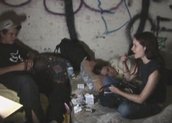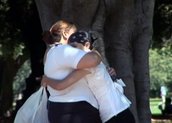


The Oasis (2008)
Synopsis
The Oasis is a feature-length observational documentary about a youth support network centre called the Oasis. It is run by the Salvation Army not far from Sydney’s city centre. The film follows the stories of five kids at the centre (Haley, Darren, Owen, Beau and Chris), and one couple (Emma and Trent). It also profiles Captain Paul Moulds of the Salvation Army, the man who has run the centre for the past 12 years, and his equally selfless wife Robbin – she dedicates her life to the same cause at the Streetlevel Mission next door.
Curator’s notes
The Oasis is confronting, intimate and inspiring. There are 22,000 homeless youths in Australia on any given night, which is a sobering statistic. The idea for the documentary came from producer and co-director Ian Darling who has had a long association with Paul Moulds and the Oasis. Darling and editor Sally Fryer asked Sascha Ettinger Epstein to co-direct and shoot the film.
Ettinger Epstein’s camera follows seven kids while they interact with people on the street, the police and each other; while they fight, get arrested, drink and take all kinds of drugs. The kids are manipulative, tough and challenging and, inside the Oasis, it is often explosive. Kids are violent, act out and demand favours.
The film also follows Paul Moulds as he goes about his daily work, where there is rarely a dull moment (see clip one). Moulds and his wife Robbin have a home life and two children but they often treat the street kids like their own. They go out of their way to care for these kids – many of whom have appalling histories of abuse, neglect and abandonment, and as a result have a difficult time functioning in society. Moulds helps find the kids places to live and even takes some of them to his own home for short stays when they can’t be housed elsewhere.
There are only 14 beds at the Oasis and they are quickly filled every night, so many kids have to find places to sleep that are under cover and hopefully safe. Some of them stay together for security. It’s obvious that Ettinger Epstein built up trust with some of these kids, who take her to their squalid squat where Owen tells his story (see clip two).
Amid the shocking stories and behaviour, there are moments of hope when a few of the kids show insight into their situation and a determination to change. As Paul Moulds says, 'You couldn’t continue in this work … if you never saw a glimmer of hope’. Paul and Robbin have changed a lot of kids’ lives over 25 years. It’s tough – some kids make it, others try and then slide back, while death seems the only way out for some. Together the Moulds soldier on and concentrate on the potential of these kids that very few others can see (see clip three).
Ian Darling is chairman of the philanthropic Caledonia Foundation that funded the documentary and also commissioned a report on homelessness, Australia’s Homeless Youth (2008). This was the first inquiry into youth homelessness since the Burdekin National Inquiry into Youth Homelessness in 1989. Darling wanted the film to show that there is something we can do about homelessness. He is also the instigator of the Documentary Australia Foundation that puts documentary filmmakers in touch with philanthropic organisations.
Ettinger Epstein shot 200 hours of footage over two years, and Darling as second unit camera added another 50 hours. They were in the editing room for six months with editor Sally Fryer, reducing these hours of footage to a feature-length film and then a shorter version for television.
The Oasis screened on the ABC on 10 April 2008 at 8.30 pm. The film won Best Direction and Best Editing in a Documentary at the AFI Awards in 2008; Best Multimodal Production and Best Tertiary Education Resource at the 2008 ATOM Awards; and the Prix Special du Jury at the 6ème Festival International du Film Documentaire Océanien in 2009.
- Overview
- Curator’s notes
- Video 3 clips
- Principal credits
- Find a copy
- Make a comment
- Map
- Add your review



